Showing Spotlights 145 - 152 of 235 in category All (newest first):
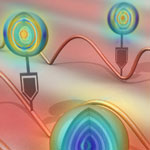 Most molecular probes used in biomedical research require dyes or fluorescence in order to obtain meaningful signals. These probes usually are quite limited with regard to the complexity of what they can image - be it the measurable concentration range or the number of molecules that can be simultaneously detected. This is an issue that is particularly relevant when it comes to track the simultaneous multiple molecular transformations that dictate complicated diseases like cancer. Scientists now have come up with an intriguing new class of molecular probes to solve this problem. They took an existing spectroscopic technique - surface-enhanced Raman scattering (SERS) - and developed a unique class of nanoparticle labels that provide for different responses when excited by laser light.
Most molecular probes used in biomedical research require dyes or fluorescence in order to obtain meaningful signals. These probes usually are quite limited with regard to the complexity of what they can image - be it the measurable concentration range or the number of molecules that can be simultaneously detected. This is an issue that is particularly relevant when it comes to track the simultaneous multiple molecular transformations that dictate complicated diseases like cancer. Scientists now have come up with an intriguing new class of molecular probes to solve this problem. They took an existing spectroscopic technique - surface-enhanced Raman scattering (SERS) - and developed a unique class of nanoparticle labels that provide for different responses when excited by laser light.
Aug 30th, 2011
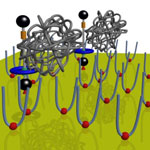 Previously, synthetic molecular machines have been used to perform mechanical tasks collectively, such as move liquid droplets uphill against the force of gravity, rotate microscale objects using liquid crystals doped with synthetic motor-molecules, and bend cantilevers. However, all these tasks are achieved by the collective action of billions and billions of molecular machines. Observing the mechanical behavior of an individual molecule is much more difficult. Synthetic molecular machines are often ten times smaller in each dimension than motor proteins and previously no one has managed to use single molecule techniques to look at how the components move in synthetic molecular machines. By using very sensitive atomic force microscopy experiments, researchers now were able to address the movement of the ring in individual rotaxane molecules.
Previously, synthetic molecular machines have been used to perform mechanical tasks collectively, such as move liquid droplets uphill against the force of gravity, rotate microscale objects using liquid crystals doped with synthetic motor-molecules, and bend cantilevers. However, all these tasks are achieved by the collective action of billions and billions of molecular machines. Observing the mechanical behavior of an individual molecule is much more difficult. Synthetic molecular machines are often ten times smaller in each dimension than motor proteins and previously no one has managed to use single molecule techniques to look at how the components move in synthetic molecular machines. By using very sensitive atomic force microscopy experiments, researchers now were able to address the movement of the ring in individual rotaxane molecules.
Aug 26th, 2011
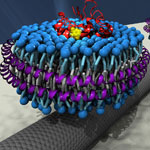 Integrating biological molecules or even complex molecular machines with man-made nanoelectronic devices is one of the ultimate goals of bionanotechnology. Already there is a growing community of researchers interested in this area of bio/nano integration where biological components are interfaced with inorganic nanomaterials to create new devices and systems that combine the desirable properties of each system. One particular nanomaterial used in this kind of research are carbon nanotubes (CNTs). Scientists now report the integration of a CNT transistor with olfactory receptor proteins. The ultimate goal of this type of research is to transfer the sensing properties of biological molecular systems to artificial electronic devices.
Integrating biological molecules or even complex molecular machines with man-made nanoelectronic devices is one of the ultimate goals of bionanotechnology. Already there is a growing community of researchers interested in this area of bio/nano integration where biological components are interfaced with inorganic nanomaterials to create new devices and systems that combine the desirable properties of each system. One particular nanomaterial used in this kind of research are carbon nanotubes (CNTs). Scientists now report the integration of a CNT transistor with olfactory receptor proteins. The ultimate goal of this type of research is to transfer the sensing properties of biological molecular systems to artificial electronic devices.
Jul 21st, 2011
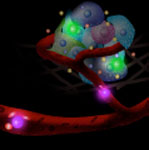 Monitoring cell functions and cell-to-cell communication has enormous implications for cell biology, regenerative medicine and tracking the fate of transplanted cells in cell therapy. Unfortunately, probing what cells 'see' and how they respond in real time to surrounding signals (i.e. cytokines) has been a major challenge. Now, a simple cell-surface sensor platform that permits signalling to be monitored within the cellular environment, in real time, in vitro and most likely also in vivo, can potentially address this problem. Researchers have developed a platform technology where cell-surface immobilized nanosensors allow them to monitor the cellular nano environment and cell-cell communication in real-time, at a single cell level and with potential unprecedented spatial and temporal resolution.
Monitoring cell functions and cell-to-cell communication has enormous implications for cell biology, regenerative medicine and tracking the fate of transplanted cells in cell therapy. Unfortunately, probing what cells 'see' and how they respond in real time to surrounding signals (i.e. cytokines) has been a major challenge. Now, a simple cell-surface sensor platform that permits signalling to be monitored within the cellular environment, in real time, in vitro and most likely also in vivo, can potentially address this problem. Researchers have developed a platform technology where cell-surface immobilized nanosensors allow them to monitor the cellular nano environment and cell-cell communication in real-time, at a single cell level and with potential unprecedented spatial and temporal resolution.
Jul 18th, 2011
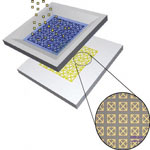 Paper has emerged as a focus area for researchers developing innovative techniques for printed basic electronics components. Another area where paper could lead to low-cost innovative devices and applications is lab-on-a-chip technology. Currently, these microfluidic devices are fairly expensive due to their lithography-based fabrication process with channels patterned in glass or plastic and tiny pumps and valves directing the flow of fluids. Inexpensive paper-based sensing kits already play an important role in ready-to-use diagnostics. Researchers have even managed to create inexpensive microfluidic platforms on hydrophobic paper with laser treatments. In a further advance, scientists have now fabricated a paper-based metamaterial device which can be potentially utilized for quantitative analysis in biochemical sensing applications.
Paper has emerged as a focus area for researchers developing innovative techniques for printed basic electronics components. Another area where paper could lead to low-cost innovative devices and applications is lab-on-a-chip technology. Currently, these microfluidic devices are fairly expensive due to their lithography-based fabrication process with channels patterned in glass or plastic and tiny pumps and valves directing the flow of fluids. Inexpensive paper-based sensing kits already play an important role in ready-to-use diagnostics. Researchers have even managed to create inexpensive microfluidic platforms on hydrophobic paper with laser treatments. In a further advance, scientists have now fabricated a paper-based metamaterial device which can be potentially utilized for quantitative analysis in biochemical sensing applications.
Jun 20th, 2011
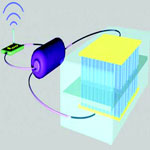 Fabrication of a single nanodevice is no longer the state of the art in nanotechnology. The leading edge - and also currently the most challenging area in nanotechnology - is research that leads to a self-powered nanoscale system that is driven by the energy harvested from its environment and that can perform its work independently and sustainable. This is a key step toward self-powered nanotechnology, which is vitally important for medical science, environmental monitoring, defence technology and even personal electronics. A research team has now provided the first demonstration that a nanogenerator can be strong enough to power a device with the capability of sensing, data processing and wireless data transmission. This is a powerful demonstration of the self-powered nanosystem and its potential applications.
Fabrication of a single nanodevice is no longer the state of the art in nanotechnology. The leading edge - and also currently the most challenging area in nanotechnology - is research that leads to a self-powered nanoscale system that is driven by the energy harvested from its environment and that can perform its work independently and sustainable. This is a key step toward self-powered nanotechnology, which is vitally important for medical science, environmental monitoring, defence technology and even personal electronics. A research team has now provided the first demonstration that a nanogenerator can be strong enough to power a device with the capability of sensing, data processing and wireless data transmission. This is a powerful demonstration of the self-powered nanosystem and its potential applications.
Jun 1st, 2011
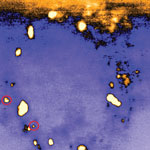 Groundbreaking research has shown a quantum atom has been tracked inside a living human cell and may lead to improvements in the testing and development of new drugs. Researchers conducted studies that confirm that non-invasive quantum measurement is possible on nanodiamonds containing a single nitrogen-vacancy (NV) spin moving within living cells. Studying the quantum properties of a single NV defect within a diamond nanocrystal, the researchers demonstrate a new technique which enables the orientation of a nanoparticle to be determined to an accuracy of less than one degree in an acquisition time of 89 milliseconds. This new technique offers biologists an extra degree of freedom when studying the translational motion of nanoparticles. Monitoring the coherence from a single electron spin paves the ways for nanoscale bio-magnetometry allowing scientists to probe changes in the cell's electromagnetic environment.
Groundbreaking research has shown a quantum atom has been tracked inside a living human cell and may lead to improvements in the testing and development of new drugs. Researchers conducted studies that confirm that non-invasive quantum measurement is possible on nanodiamonds containing a single nitrogen-vacancy (NV) spin moving within living cells. Studying the quantum properties of a single NV defect within a diamond nanocrystal, the researchers demonstrate a new technique which enables the orientation of a nanoparticle to be determined to an accuracy of less than one degree in an acquisition time of 89 milliseconds. This new technique offers biologists an extra degree of freedom when studying the translational motion of nanoparticles. Monitoring the coherence from a single electron spin paves the ways for nanoscale bio-magnetometry allowing scientists to probe changes in the cell's electromagnetic environment.
May 26th, 2011
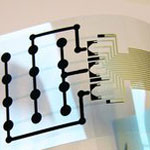 Printed electronics is one of the most important new enabling technologies. It will have a major impact on most business activities from publishing and security printing to healthcare, automotive, military and consumer packaged goods sectors. With recent advances, power and energy storage can be integrated into the printing process, making their potential applications even more ubiquitous. Currently, though, the more complex printed components that require a combination of different class of devices, still experience drawbacks in performance, cost, and large-scale manufacturability. Researchers have now succeeded in fabricating a multi-component sensor array by simple printing techniques - all components (polymer sensor array, organic transistors, electrochromic display) are integrated on the same flexible substrate.
Printed electronics is one of the most important new enabling technologies. It will have a major impact on most business activities from publishing and security printing to healthcare, automotive, military and consumer packaged goods sectors. With recent advances, power and energy storage can be integrated into the printing process, making their potential applications even more ubiquitous. Currently, though, the more complex printed components that require a combination of different class of devices, still experience drawbacks in performance, cost, and large-scale manufacturability. Researchers have now succeeded in fabricating a multi-component sensor array by simple printing techniques - all components (polymer sensor array, organic transistors, electrochromic display) are integrated on the same flexible substrate.
Apr 13th, 2011
 Most molecular probes used in biomedical research require dyes or fluorescence in order to obtain meaningful signals. These probes usually are quite limited with regard to the complexity of what they can image - be it the measurable concentration range or the number of molecules that can be simultaneously detected. This is an issue that is particularly relevant when it comes to track the simultaneous multiple molecular transformations that dictate complicated diseases like cancer. Scientists now have come up with an intriguing new class of molecular probes to solve this problem. They took an existing spectroscopic technique - surface-enhanced Raman scattering (SERS) - and developed a unique class of nanoparticle labels that provide for different responses when excited by laser light.
Most molecular probes used in biomedical research require dyes or fluorescence in order to obtain meaningful signals. These probes usually are quite limited with regard to the complexity of what they can image - be it the measurable concentration range or the number of molecules that can be simultaneously detected. This is an issue that is particularly relevant when it comes to track the simultaneous multiple molecular transformations that dictate complicated diseases like cancer. Scientists now have come up with an intriguing new class of molecular probes to solve this problem. They took an existing spectroscopic technique - surface-enhanced Raman scattering (SERS) - and developed a unique class of nanoparticle labels that provide for different responses when excited by laser light.
 Subscribe to our Nanotechnology Spotlight feed
Subscribe to our Nanotechnology Spotlight feed





